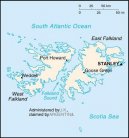| Introduction - Falkland Islands (Islas Malvinas): |
| Location - Falkland Islands (Islas Malvinas): |
| People - Falkland Islands (Islas Malvinas): |
| Government - Falkland Islands (Islas Malvinas): |
| Economy - Falkland Islands (Islas Malvinas): |
Economy overview | The economy was formerly based on agriculture, mainly sheep farming, but today fishing contributes the bulk of economic activity. In 1987 the government began selling fishing licenses to foreign trawlers operating within the Falkland Islands exclusive fishing zone. These license fees total more than $40 million per year, which help support the islands health, education, and welfare system. Squid accounts for 75% of the fish taken. Dairy farming supports domestic consumption; crops furnish winter fodder. Exports feature shipments of high-grade wool to the UK and the sale of postage stamps and coins. The islands are now self-financing except for defense. The British Geological Survey announced a 200-mile oil exploration zone around the islands in 1993, and early seismic surveys suggest substantial reserves capable of producing 500,000 barrels per day; to date, no exploitable site has been identified. An agreement between Argentina and the UK in 1995 seeks to defuse licensing and sovereignty conflicts that would dampen foreign interest in exploiting potential oil reserves. Tourism, especially eco-tourism, is increasing rapidly, with about 30,000 visitors in 2001. Another large source of income is interest paid on money the government has in the bank. The British military presence also provides a sizeable economic boost. |
|
Gdp purchasing power parity | $75 million (2002 est.) |
|
Gdp official exchange rate | NA |
|
Gdp real growth rate | NA% |
|
Gdp per capita ppp | $25,000 (2002 est.) |
|
Gdp composition by sector | agriculture: 95%
industry: NA%
services: NA% |
|
Labor force | 1,724 (est.) (1996) |
|
Labor force by occupation | agriculture: 95% (mostly sheepherding and fishing)
industry and services: 5% |
|
Unemployment rate | full employment; labor shortage (2001) |
|
Population below poverty line | NA% |
|
Household income or consumption by percentage share | lowest 10%: NA%
highest 10%: NA% |
|
Inflation rate consumer prices | 3.6% (1998) |
|
Budget | revenues: $66.2 million
expenditures: $67.9 million; including capital expenditures of $23.2 million (FY98/99 est.) |
|
Agriculture products | fodder and vegetable crops; sheep, dairy products; fish, squid |
|
Industries | fish and wool processing; tourism |
|
Industrial production growth rate | NA% |
|
Electricity production | 16 million kWh (2004) |
|
Electricity consumption | 14.88 million kWh (2004) |
|
Electricity exports | 0 kWh (2004) |
|
Electricity imports | 0 kWh (2004) |
|
Oil production | 0 bbl/day (2004 est.) |
|
Oil consumption | 230 bbl/day (2004 est.) |
|
Oil exports | NA bbl/day |
|
Oil imports | NA bbl/day |
|
Oil proved reserves | 0 bbl |
|
Natural gas production | 0 cu m (2004 est.) |
|
Natural gas consumption | 0 cu m (2004 est.) |
|
Exports | $125 million (2004 est.) |
|
Exports commodities | wool, hides, meat, fish, squid |
|
Exports partners | Spain 81.9%, US 6%, UK 4.5% (2006) |
|
Imports | $90 million (2004 est.) |
|
Imports commodities | fuel, food and drink, building materials, clothing |
|
Imports partners | UK 72.5%, US 15.1%, Netherlands 8.5% (2006) |
|
Debt external | $NA |
|
Economic aid recipient | $0 (1997 est.) |
|
Currency code | Falkland pound (FKP) |
|
Exchange rates | Falkland pounds per US dollar - 0.5434 (2006), 0.5504 (2005), 0.5462 (2004), 0.6125 (2003), 0.6672 (2002)
note: the Falkland pound is at par with the British pound |
|
| Communications - Falkland Islands (Islas Malvinas): |
| Transportation - Falkland Islands (Islas Malvinas): |
| Military - Falkland Islands (Islas Malvinas): |
This page was last updated on 16 September, 2007



